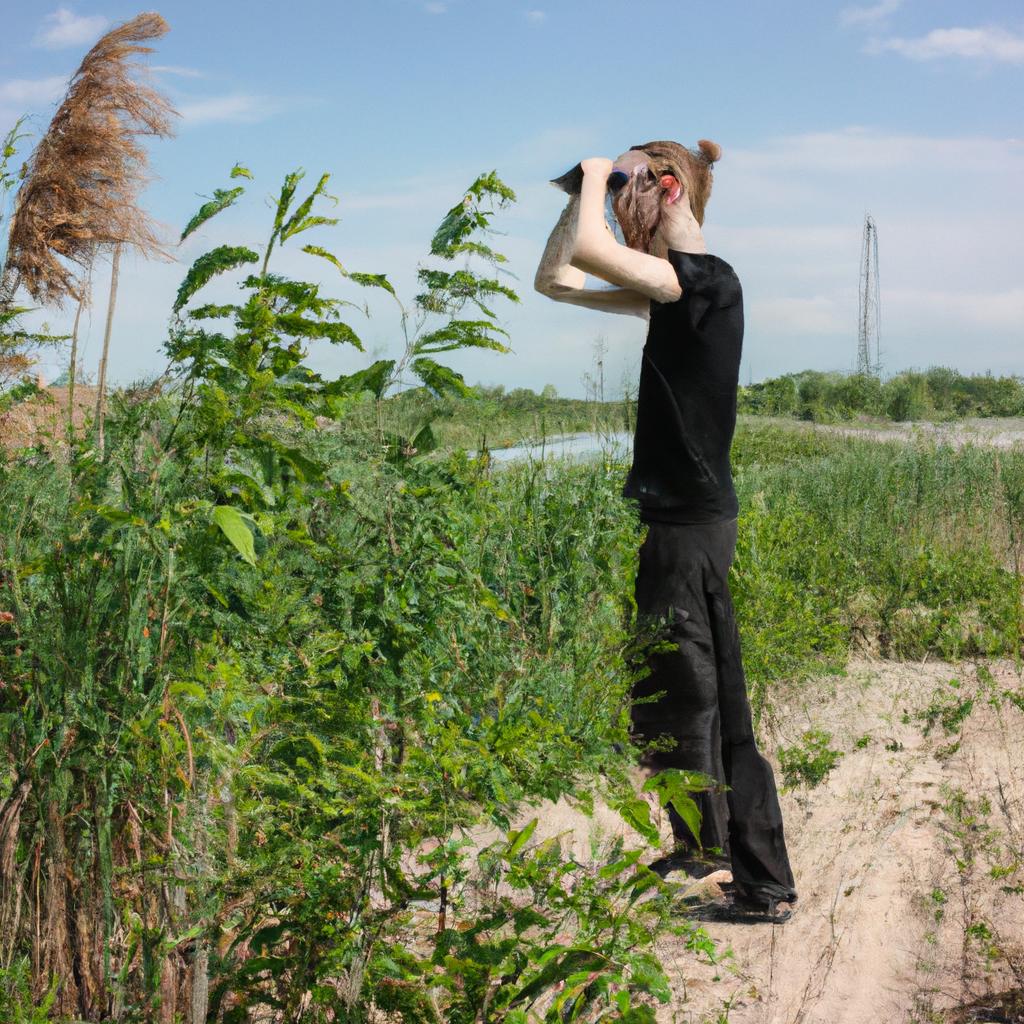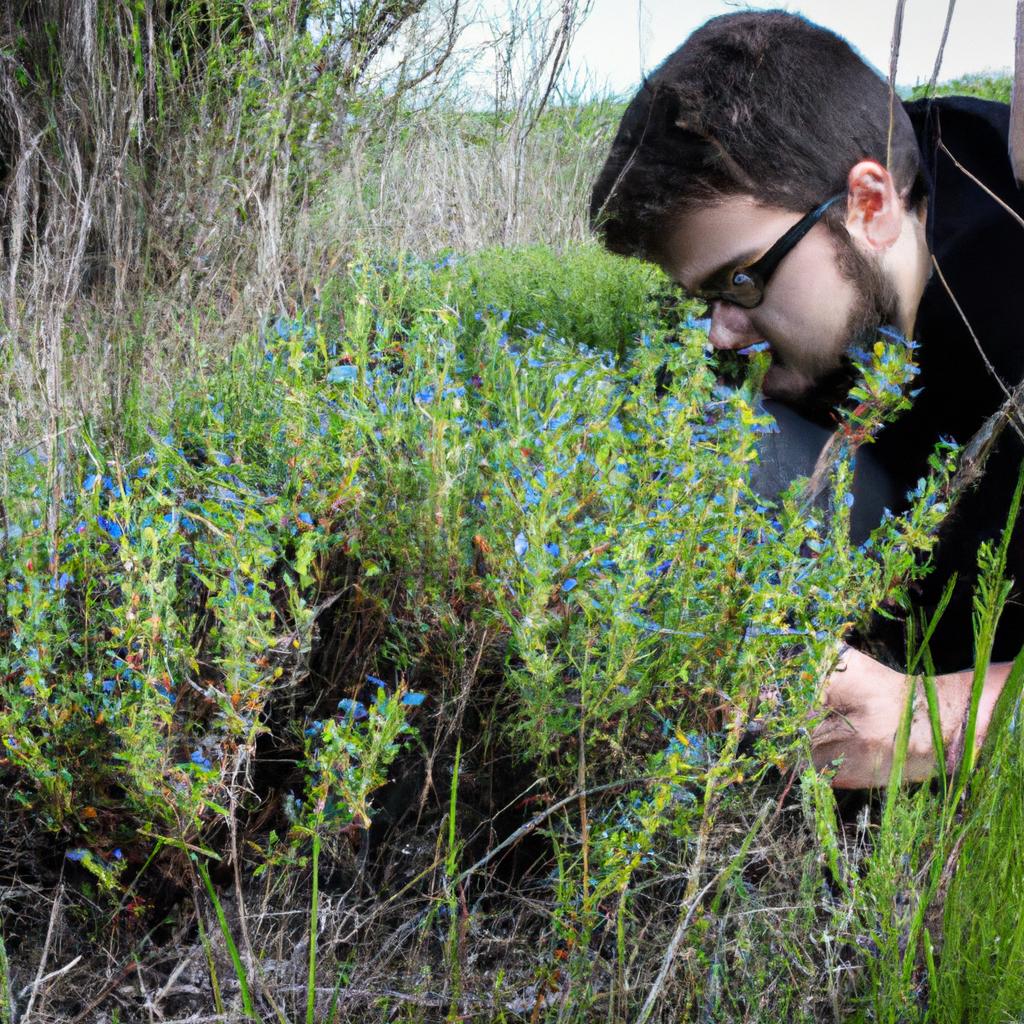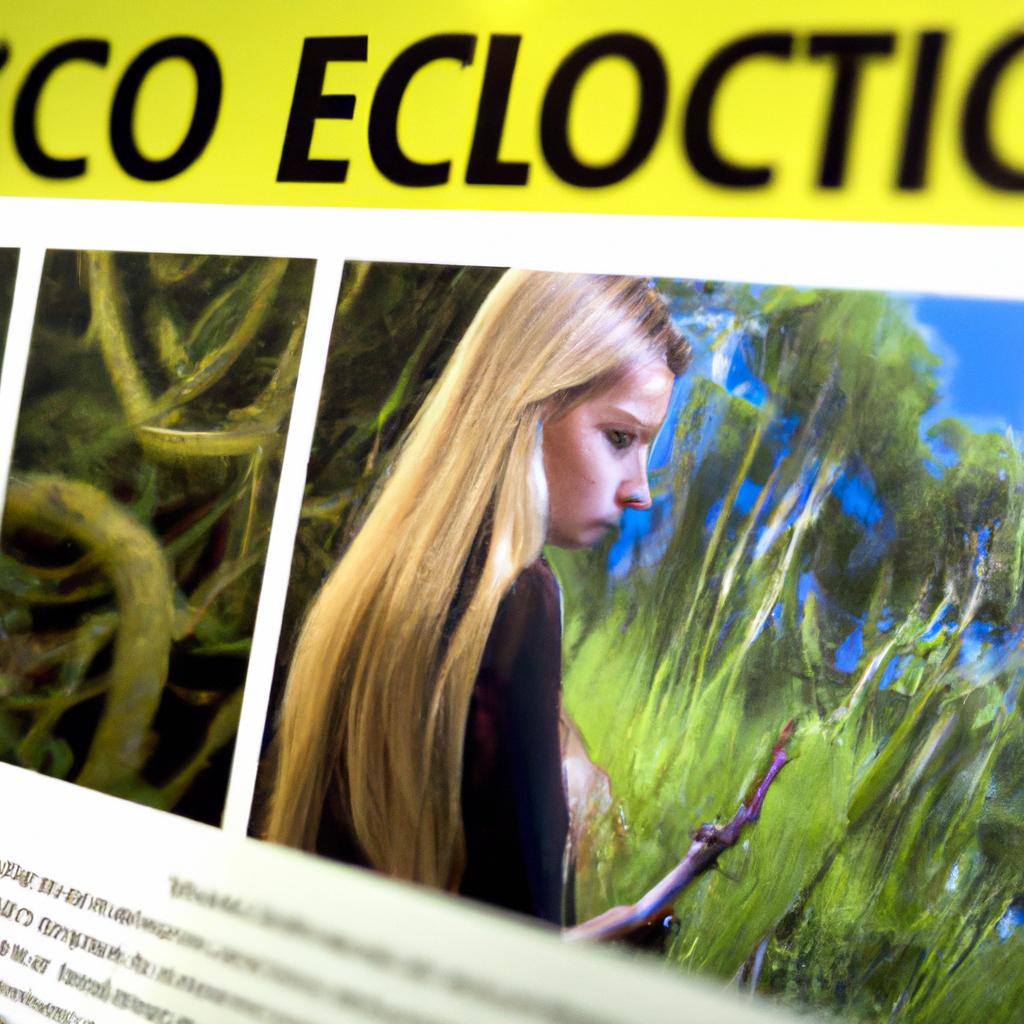Ecological Succession: The Dynamics of Biology and Ecology

Ecological succession is a fundamental concept in biology and ecology that explores the dynamic interactions between organisms and their environment over time. It describes the predictable sequence of changes that occur in an ecosystem following a disturbance or colonization event, leading to the establishment of a stable community. To illustrate this phenomenon, let us consider the hypothetical case of a volcanic eruption on an island. Initially, the land may be barren and devoid of life, but as time progresses, various species will gradually colonize the area, each playing a crucial role in shaping the ecological structure and function.
This process of ecological succession can be divided into two main types: primary succession and secondary succession. Primary succession occurs when new land surfaces are formed through geological events such as lava flows or glacial retreats. In these cases, there is no pre-existing soil present, making it challenging for plants to establish themselves initially. However, pioneer species like lichens and mosses are capable of surviving under harsh conditions by breaking down rocks and organic matter to create basic soil nutrients. These hardy pioneers pave the way for other more complex plant species which then attract animals seeking food and shelter. As time passes, the ecosystem becomes increasingly diverse and stable.
Secondary succession refers to the recovery process after disturbances that have not removed all life and soil from an area. Examples of disturbances that can lead to secondary succession include wildfires, deforestation, or human activities such as agriculture or construction. In these cases, the soil is already present, providing a foundation for plant growth. Pioneer species like grasses and shrubs quickly colonize the area, followed by larger plants such as trees. As the vegetation becomes established, it creates a more suitable habitat for other organisms to return or colonize. Over time, the community structure and composition gradually restore to a state similar to what existed before the disturbance.
It is important to note that ecological succession is not a linear process with strict stages but rather a dynamic and complex series of interactions between organisms and their environment. The specific trajectory of succession depends on various factors such as climate, available resources, and the characteristics of the species involved. Additionally, disturbances can reset or alter successional trajectories, leading to different outcomes.
Understanding ecological succession is crucial for ecologists and conservationists as it helps explain how ecosystems recover from disturbances and provides insights into ecosystem resilience and management strategies.
Primary Succession: The Pioneer Species and the Beginnings of Life
Primary Succession: The Pioneer Species and the Beginnings of Life
Ecological succession is a fundamental process that occurs in ecosystems, driving changes in biodiversity and community composition over time. One crucial phase of ecological succession is primary succession, which takes place in areas devoid of any life or organic matter. In this section, we will explore the role of pioneer species and their significance in initiating the colonization process.
To illustrate the concept of primary succession, let us consider an example scenario: a volcanic island emerging from the depths of the ocean. As lava cools and solidifies, it creates a barren landscape with no pre-existing soil or vegetation. Here, primary succession begins as organisms gradually colonize this inhospitable environment.
Pioneer species are the first organisms to establish themselves in these harsh conditions. They possess remarkable adaptive traits that enable them to withstand extreme temperatures, limited nutrients, and other challenging abiotic factors. Algae, lichens, mosses, and fungi are typical pioneer species found during early stages of primary succession due to their ability to survive on bare rocks through mechanisms such as nutrient absorption from rainwater.
A bullet point list can help highlight key characteristics associated with primary succession:
- Resilience: Pioneer species exhibit exceptional resilience by tolerating adverse environmental conditions.
- Colonization: These hardy organisms facilitate soil formation by breaking down rocks into smaller particles through physical or chemical weathering processes.
- Nutrient cycling: Pioneer species play a pivotal role in nutrient cycling by absorbing minerals from rocks or air-borne deposits.
- Habitat modification: Through root growth and decomposition processes, pioneers modify their surroundings physically and chemically for subsequent plant communities.
In addition to bullet points, another effective way to convey information is by using tables. Below is an example table showcasing some common pioneer species along with their unique adaptations:
| Pioneer Species | Adaptations |
|---|---|
| Lichens | Symbiotic association between fungi and algae; can fix nitrogen from the atmosphere |
| Mosses | Ability to retain water and nutrients in harsh conditions |
| Algae | Photosynthetic pigments that allow them to photosynthesize even in low light environments |
| Fungi | Capability to break down complex organic matter into simpler forms, aiding in soil development |
Understanding the role of pioneer species is crucial as it sets the stage for subsequent ecological developments and transitions.
Transitioning smoothly into the subsequent section about “Climax Communities: Stability and Balance in Ecological Succession,” it becomes clear that primary succession acts as a critical foundation for further ecological transformations.
Climax Communities: Stability and Balance in Ecological Succession
From the barren landscapes of primary succession, where pioneer species lay the foundation for life to flourish, ecosystems gradually evolve into climax communities that achieve stability and balance. This section explores the intricate dynamics of ecological succession as it transitions from early stages to more mature states. Using a hypothetical example set in a volcanic island, we will delve into the various factors influencing this process.
Imagine an uninhabited volcanic island emerging from beneath the ocean’s surface. As lava cools and solidifies, bare rocks are exposed to harsh environmental conditions devoid of any life forms. Over time, windblown seeds or those carried by birds find their way onto these newly formed shores, initiating the first stage of colonization. Pioneer plants such as lichens and mosses establish themselves on the rocky terrain, breaking down minerals and organic matter through biological weathering processes. Their presence creates small pockets of soil capable of supporting more complex vegetation.
During subsequent stages of ecological succession, herbaceous plants take root in the enriched soil created by pioneer species. These plant communities provide further stabilization against erosion while attracting insects and other pollinators crucial for reproduction. As shrubs and trees begin to dominate the landscape, they create shade and modify microclimates within their immediate vicinity, enabling new species with specific habitat requirements to thrive.
The progression toward climax communities is marked by distinct characteristics:
- Increased biodiversity: With each successive wave of colonization, new species join pre-existing ones, resulting in greater diversity within ecosystems.
- Nutrient cycling: As organisms die or decompose over time, nutrients become recycled back into the ecosystem through decomposition processes facilitated by bacteria and fungi.
- Enhanced ecological services: Mature ecosystems offer vital services like carbon sequestration, water filtration, climate regulation, and wildlife habitats.
- Resilience to disturbance: Climax communities possess high resilience due to their stable structures and diverse species composition.
To illustrate this concept visually (please see table below), consider a comparison between the early stages of primary succession and a mature climax community:
| Primary Succession | Climax Community | |
|---|---|---|
| Dominant Species | Pioneer plants | Diverse species |
| Biodiversity | Low | High |
| Soil Development | Initial formation | Fully developed |
| Ecosystem Services | Limited | Abundant |
As we reflect on the ongoing journey toward ecological stability, it becomes evident that resilience is a fundamental characteristic of these complex systems. In the subsequent section, “Disturbance and Secondary Succession: Nature’s Reset Button,” we will explore how disturbances interrupt this progression and initiate new cycles of succession.
[Transition Sentence] Disturbances play a vital role in shaping ecosystems, providing opportunities for renewal following disruption. By examining secondary succession dynamics, we can gain further insights into nature’s remarkable ability to rebound from adversity without skipping a beat.
Disturbance and Secondary Succession: Nature’s Reset Button
Building upon our understanding of climax communities, we now explore how these stable and balanced ecosystems contribute to overall ecological stability. By examining their intricate dynamics, we can gain insights into the mechanisms that promote long-term sustainability and resilience in natural environments.
One captivating example illustrating the importance of climax communities is the temperate rainforest ecosystem found in the Pacific Northwest region of North America. This complex system undergoes a series of successional stages following disturbances such as wildfires or clear-cutting activities. Over time, it regenerates itself until reaching its peak state—the climax community dominated by towering coniferous trees like Douglas firs and western hemlocks. These ancient forests provide habitat for diverse species, including endangered ones like spotted owls and marbled murrelets. They also play a crucial role in carbon sequestration and water regulation within the region.
Understanding the significance of climax communities requires us to delve into several key aspects:
- Biodiversity: Climax communities exhibit high levels of biodiversity due to their stable conditions over extended periods. This allows numerous plant and animal species to coexist, forming intricate webs of interactions that support overall ecosystem functioning.
- Nutrient Cycling: The presence of mature vegetation in climax communities promotes efficient nutrient cycling through processes such as decomposition and mineralization. As organic matter accumulates on the forest floor, it enriches soil fertility, facilitating vigorous growth in plants while sustaining various trophic levels.
- Resistance to Disturbances: Due to their advanced stage of succession, climax communities often demonstrate heightened resistance against disturbances compared to earlier successional stages. Their well-established structure and functional relationships enable them to withstand moderate disturbances without undergoing drastic changes or losing valuable components.
- Resilience: In addition to resistance, climax communities display remarkable resilience when faced with severe disruptions—a testament to their ability to rebound after disturbances. This resilience is attributed to the presence of diverse species and their interactions, which contribute to ecosystem stability through redundancy and complementary functions.
Table: The Importance of Climax Communities
| Aspects | Significance |
|---|---|
| Biodiversity | Supports intricate ecological relationships |
| Nutrient Cycling | Enhances soil fertility and plant growth |
| Resistance to Disturbances | Maintains overall structure after moderate disruptions |
| Resilience | Enables rapid recovery from severe disturbances |
As we comprehend the multifaceted role of climax communities in maintaining ecosystem stability, we can now explore another vital aspect of succession—facilitation. By understanding how species interact positively during different stages of succession, we gain further insights into the complex dynamics that shape our natural world.
Next section: ‘Facilitation: How Species Help Each Other in Succession’
Facilitation: How Species Help Each Other in Succession
In the previous section, we explored how disturbances play a crucial role in initiating secondary succession. Now, let us delve deeper into the mechanisms that drive this process and understand its implications for ecosystems. To illustrate these concepts, consider the hypothetical case of a forest fire sweeping through a densely wooded area.
Upon analyzing the aftermath of the forest fire, researchers observed several key phenomena:
-
Pioneer Species Establishment: In areas where the fire was intense, most plant life was consumed or severely damaged. However, some species known as pioneer plants were quick to colonize the newly available space. These resilient organisms can tolerate harsh conditions and often have specialized adaptations that allow them to thrive in post-disturbance environments.
-
Soil Recovery: While fires may devastate above-ground vegetation, they also bring about unique changes below ground. The intense heat from the flames breaks down organic matter into essential nutrients that enrich the soil. As time progresses, nutrient availability increases, providing an advantageous environment for subsequent waves of plant colonization.
-
Community Assembly: Over time, different plant species begin to establish themselves within the recovering ecosystem. This gradual transition leads to changes in community composition and structure as new populations replace earlier pioneers. Through competition for resources and interactions among various species, communities become more diverse and complex.
To comprehend these processes further, let us explore their dynamics using a three-column table showcasing contrasting stages during secondary succession after a disturbance like a forest fire:
| Stage | Characteristics | Example |
|---|---|---|
| Early Succession | Dominated by pioneer species | Mosses growing on charred logs |
| Mid-Succession | Transitioning towards shade-tolerant species | Shrubs such as blueberry bushes |
| Late Succession | Climax community with stable and long-lived species | Mature oak trees in a forest |
This table aims to evoke an emotional response by highlighting the resilience of nature and its ability to rebound from destructive events. It showcases the gradual progression towards ecological stability, reminding us of the inherent cycle of disturbance and recovery that characterizes our natural world.
In light of these observations, it becomes evident that secondary succession is a dynamic process driven by various factors such as pioneer species establishment, soil recovery, and community assembly. Understanding these mechanisms is crucial for effective ecosystem management and conservation efforts.
Next, we will delve into the intricate relationship between colonization and species diversity—two essential components that shape the trajectory of succession. By exploring their interplay, we can uncover key insights into the complex dynamics at play within ecosystems undergoing change.
Colonization and Species Diversity: The Key Players in Succession
To better understand the dynamics of ecological succession, it is crucial to explore the role of disturbance in shaping ecosystems. Disturbances can range from natural events like fires and storms to anthropogenic activities such as deforestation or urbanization. These disturbances disrupt existing communities, leading to changes that trigger a cascade of processes involved in recovery and subsequent successional stages.
Example:
Consider a hypothetical scenario where a severe wildfire engulfs a dense forest ecosystem. The intense heat destroys vegetation, leaving behind charred remains and barren soil. In this case, disturbance acts as a reset button for succession, prompting an opportunity for new species to colonize the area.
Role of Disturbance:
- Creation of Open Niches: Disturbances create open niches or habitats with reduced competition for resources. This allows pioneer species – typically fast-growing and adaptable organisms – to establish themselves first.
- Facilitation by Early Colonizers: Pioneer species play a pivotal role in facilitating the establishment of other plant and animal species during early succession. They improve soil conditions, provide shade or shelter, and alter microclimates which enable less tolerant species to thrive.
- Species Diversity Over Time: As time progresses after disturbance, more diverse species gradually replace pioneers through competitive exclusion or niche differentiation. This leads to increased complexity within the community, fostering greater biodiversity.
- Successional Trajectories: Depending on factors such as severity, frequency, and type of disturbance encountered, different successional trajectories may arise. For instance, frequent low-severity disturbances may result in cyclic patterns characterized by rapid turnover between similar communities.
Table: Examples of Disturbance Types
| Type | Natural Example | Anthropogenic Example |
|---|---|---|
| Fire | Lightning-induced | Controlled burn |
| Storm | Tornado | Hurricane |
| Flooding | River overflow | Dam release |
| Deforestation | Insect outbreaks | Clear-cut logging |
Understanding the role of disturbance in ecological succession is vital, as it allows us to recognize how disruptions shape and influence ecosystems. By studying the effects of different types of disturbances on successional processes, we can gain insight into ecosystem resilience and recovery potentials. Subsequently, this knowledge becomes crucial in mitigating human impact on ecological succession.
As humans continue to alter natural landscapes at an unprecedented rate, their actions have profound consequences for ecological succession. The next section will delve into the disruptions caused by human activities and their subsequent impacts on the delicate balance of ecological systems.
Human Impact on Ecological Succession: Disruptions and Consequences
As we have explored the vital role played by colonization and species diversity in ecological succession, it is crucial to acknowledge the significant impact that human activities can have on this natural process. Understanding how humans disrupt ecological succession will provide insights into the consequences for ecosystems. By examining a hypothetical case study involving deforestation, we can shed light on these disruptions.
Imagine an expansive forest teeming with diverse flora and fauna. This ecosystem has undergone various stages of ecological succession, evolving over centuries. However, due to human intervention through widespread deforestation, large areas of this once-thriving forest are cleared for agricultural purposes or urban development. This disruption halts the natural progression of succession, leading to severe consequences for both the environment and society.
To comprehend the ramifications of such disruptions, consider the following emotional response-inducing bullet points:
- Loss of biodiversity:
- Destruction of habitats leads to the extinction or displacement of numerous plant and animal species.
- Reduction in genetic variability diminishes resilience against environmental changes.
- Imbalance in predator-prey relationships may result in population explosions or crashes.
The table below provides a visual overview of some key consequences resulting from disrupting ecological succession:
| Consequence | Description | Implications |
|---|---|---|
| Soil erosion | Removal of vegetation exposes soil to erosive forces | Increased sedimentation in water bodies; reduced fertility |
| Climate change | Alteration of carbon cycle affects global climate | Heightened greenhouse gas emissions; disrupted weather patterns |
| Water scarcity | Deforestation disrupts hydrological cycles | Reduced water availability; increased risk of droughts |
| Loss of ecosystem services | Disruption in natural processes and functions | Diminished pollination, nutrient cycling, and carbon sequestration capabilities |
In light of these consequences, it is evident that human activities can have far-reaching effects on ecological succession. By disrupting the delicate balance within ecosystems, we undermine their resilience and threaten the well-being of both present and future generations.
Through this exploration of disruptions caused by human impact on ecological succession, we are reminded of our collective responsibility to protect and restore these invaluable systems. Only through sustainable practices and conservation efforts can we mitigate the adverse consequences outlined above and ensure a harmonious coexistence between humans and nature.









